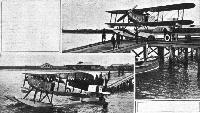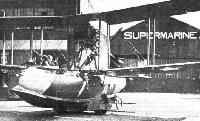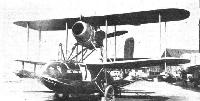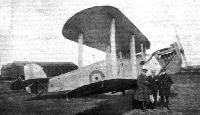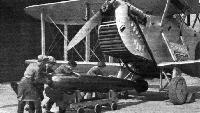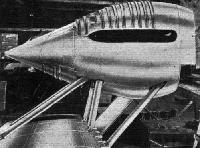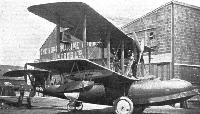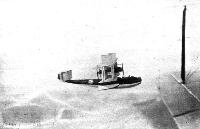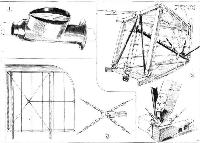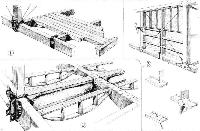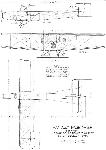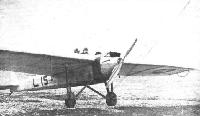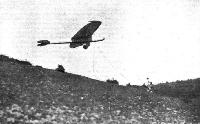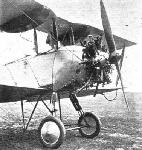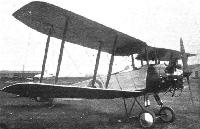Фотографии
-
THE FLIGHT AROUND AUSTRALIA: The photographs above show the Fairey III-D seaplane, with Rolls-Royce "Eagle IX" engine, on which Wing-Commander S. J. Goble, D.S.O., O.B.E., D.S.C., and Flying Officer L. E. MacIntyre, of the Royal Australian Air Force, have just succeeded in completing their 9,000 miles flight around Australia. The performance is one worthy of ranking among the foremost flights ever made, and reflects the greatest credit not only on the gallant officers who made it, but also on the machine and engine. The photographs show the machine at Point Cook, near Melbourne.
Самолёты на фотографии: Fairey Fairey III - Великобритания - 1917
-
The Vickers "Viking Commercial" is very similar to the service type, and can also be supplied fitted with a Rolls-Royce "Eagle IX" engine.
Самолёты на фотографии: Vickers Viking / Type 54 - Великобритания - 1919
-
Регистрационный номер: G-EBFO The D.H.50 Landing at about 40 m.p.h. Air Speed: The flaps are right down, and it should be noted that although the machine is very near its stalling angle the tail is well up.
Самолёты на фотографии: De Havilland D.H.50 - Великобритания - 1923
-
THE DE HAVILLAND AUTOMATIC CAMBERING DEVICE: On the left the inspection door on the lower starboard wing is shown open, disclosing the aileron sprocket. On the right a view underneath the wing, showing the crank, rod, and king-post of the aileron and flap control.
Самолёты на фотографии: De Havilland D.H.50 - Великобритания - 1923
-
Trailing edge flap of the D.H. 50. The aileron extends over the whole span of the wings.
Самолёты на фотографии: De Havilland D.H.50 - Великобритания - 1923
-
The Supermarine naval training school machine is a three-seater.
Самолёты на фотографии: A.D. Flying Boat - Великобритания - 1916
-
The Boulton and Paul "Bourges" all-metal machine is a long-distance reconnaissance three-seater. The engines are Napier "Lions."
Самолёты на фотографии: Boulton Paul Bourges / P.7 - Великобритания - 1918
-
A SUCCESSFUL HELICOPTER: Two views of the latest Berliner helicopter, constructed by Henry A. Berliner, of Washington, U.S.A., which has recently been making successful demonstrations before officials of the U.S. Army Air Service.
Самолёты на фотографии: Berliner helicopter - США - 1921
-
The Armstrong-Whitworth "Awana" is a troop carrier, with seating capacity for 25 troops.
Самолёты на фотографии: Armstrong Whitworth Awana - Великобритания - 1923
-
Регистрационный номер: J6921 The Armstrong-Whitworth "Wolf" (Siddeley "Jaguar") , a two-seater Corps Reconnaissance machine.
Самолёты на фотографии: Armstrong Whitworth Wolf - Великобритания - 1923
-
Регистрационный номер: G-EBAH The Supermarine "Sea Lion" is a fighting scout amphibian, with Napier "Lion" engine. It is similar to the Schneider Cup racer of 1923.
Самолёты на фотографии: Supermarine Sea Lion / Sea King - Великобритания - 1919
-
SALUTING THE DOMINION PREMIERS AT CROYDON: The Blackburn "Dart" flying above the Blackburn "Blackburn" fleet spotter. Both are fitted with Napier "Lion" engines.
Самолёты на фотографии: Blackburn Blackburn / R.1 - Великобритания - 1922Blackburn Swift T.1 / Dart T.2 - Великобритания - 1920
-
The Blackburn "Swift" torpedo plane single-seater, Napier "Lion" engine. Can also be supplied as a two-seater Bomber.
Самолёты на фотографии: Blackburn Swift T.1 / Dart T.2 - Великобритания - 1920
-
Loading a torpedo on the Blackburn "Swift" torpedo 'plane, Napier "Lion" engine.
Самолёты на фотографии: Blackburn Swift T.1 / Dart T.2 - Великобритания - 1920
-
Регистрационный номер: G-EBHG [2] A "Bristol" within the Arctic Circle: The Bristol Fighter, with Bristol "Jupiter" engine, starting for a flight at Kiruna aerodrome, Sweden. Note the ski undercarriage.
Самолёты на фотографии: Bristol Jupiter-Fighter / Advanced Trainer - Великобритания - 1923
-
Регистрационный номер: G-EBHG [2] Landing on the Snow: The Bristol Fighter alighting at Kiruna after a trial flight.
Самолёты на фотографии: Bristol Jupiter-Fighter / Advanced Trainer - Великобритания - 1923
-
The "Kingston" is a five-seater reconnaissance flying-boat, designed and built by the English Electric Company. The engines fitted are two Napier "Lions." Our photograph shows a scale model of the "Kingston."
Самолёты на фотографии: Phoenix Cork / P.5 - Великобритания - 1918
-
The Short "Springbok" is an all-metal two-seater fighter with 400 h.p. Bristol "Jupiter" engine.
Самолёты на фотографии: Short Springbok / Chamois / S.3 - Великобритания - 1923
-
Sketch elevations and plans of the Fiat "R.S." and "B.R." models.
Самолёты на фотографии: FIAT BR - Италия - 1919
-
Two views of the Fiat "C.R." single-seater fighter, 300 h.p. Hispano-Suiza.
Самолёты на фотографии: FIAT CR - Италия - 1923
-
FIAT "CR" Single Seater Fighter 300 hp Hispano-Suiza
Самолёты на фотографии: FIAT CR - Италия - 1923
-
Регистрационный номер: G-EBJY The Supermarine "Swan" twin-engined amphibian flying boat is probably the first machine of its type in the world. The engines are Rolls-Royce "Eagle IX"
Самолёты на фотографии: Supermarine Swan - Великобритания - 1924
-
Регистрационный номер: G-EAXZ, J7234 THE "GLOSTER": A side view of the Gloucestershire Aircraft Company's world's record speed machine "Gloster," which won the Aerial Derby last Monday. A front view of this, aeroplane appeared last week exclusively in "Flight." The engine is a 450 h.p. Napier "Lion."
The Gloucestershire ''Gloster" won the 1923 Aerial Derby at a speed of slightly less than 200 m.p.h.Самолёты на фотографии: Gloster I - III - Великобритания - 1923
-
Регистрационный номер: JN400 The Gloucestershire "Mars II" is a single-seater fighter with 230 h.p. B.R.II rotary engine.
The first Sparrowhawk I land-based fighter for the Imperial Japanese Navy.Самолёты на фотографии: Gloster Mars (Bamel) / Nighthawk / Sparrowhawk - Великобритания - 1921
-
The Gloucestershire "Mars VI" is a high-performance singleseater fighter, with very wide speed range and excellent climb. It is variously fitted with 400 h.p. Bristol "Jupiter" or Armstrong-Siddeley 370 h.p. "Jaguar" engine. The photograph shows the "Jupiter" machine.
Самолёты на фотографии: Gloster Mars (Bamel) / Nighthawk / Sparrowhawk - Великобритания - 1921
-
A MODERN U.S. NAVY SCOUTING TWIN-ENGINED FLYING BOAT: This flying boat, known officially as the P.N.7. is an improvement on the famous F.5.L. flying boat. It retains the latter's hull, but is fitted with high-performance wings, as a result of which the overall span has been reduced by some 20 ft. Two 550 h.p. Wright T.2 heavy duty engines are fitted.
Самолёты на фотографии: Naval Aircraft Factory PN - США - 1922
-
INTERESTING "ST.LOUIS" MACHINE: We show one of the many types of machines that took part in the 1923 St. Louis Air Races. The CO.5 (400 h.p. Liberty), a modification of the Fokker D.VII built by the U.S. Army Air Department at McCook Field. It obtained third place in the Liberty Engine Builders' Trophy Race.
Самолёты на фотографии: Engineering Division TP-1 - США - 1924
-
The cowling of one of the Rolls-Royce engines. The petrol tanks are mounted under the wing, while slightly farther out may be seen the floats that give lateral stability on the water.
Самолёты на фотографии: Rohrbach Ro.II - Ro.IV - Германия - 1923
-
The Rohrbach all-metal Monoplane Flying Boat: This machine, designed by Herr Rohrbach and built by the Rohrbach Aeroplane Company of Copenhagen, is fitted with two Rolls-Royce "Eagle" engines. In the view the machine is seen on the ground, with four large wheels for transport.
Самолёты на фотографии: Rohrbach Ro.II - Ro.IV - Германия - 1923
-
Регистрационный номер: N146 The Supermarine "Seagull" is a deck-landing amphibian fleet spotter with Napier "Lion'' engine. An unusual feature is the tractor airscrew.
Самолёты на фотографии: Supermarine Seal / Seagull - Великобритания - 1921
-
Регистрационный номер: G-EBFC The Vickers "Vulcan," in its latest form, is an eight-seater passenger machine, with Napier "Lion" engine.
Самолёты на фотографии: Vickers Vulcan / Type 61 - Великобритания - 1922
-
THE R.A.F. AERIAL PAGEANT: Interesting machine which will make its first public appearance at the Pageant: The Westland "Weasel," a fighting and reconnaissance machine fitted with either a 380 Bristol "Jupiter" or a 320 Siddeley "Jaguar."
Самолёты на фотографии: Westland Weasel - Великобритания - 1918
-
INTERESTING "ST.LOUIS" MACHINE: We show one of the many types of machines that took part in the 1923 St. Louis Air Races. The Verville-Sperry cantilever monoplane, 500 h.p. Curtiss D.12 special engine, which was entered by the U.S. Army in the Pulitzer Race.
Самолёты на фотографии: Verville Verville-Sperry Racer / R-3 - США - 1922
-
A row of "Bristol" school machines, fitted with three-cylinder Bristol "Lucifer" engines.
Самолёты на фотографии: Bristol Taxiplane / Primary Trainer - Великобритания - 1923
-
A NEW SOPWITH-HAWKER MACHINE: The "Duiker" is a two-seater corps reconnaissance monoplane, fitted with Bristol "Jupiter" or Siddeley "Jaguar" engine. The machine shown in the photograph has the former engine. As the "Duiker" is built for the Air Ministry, no detail information concerning it may be published. Note the tapering wing, which is thinned down in the centre so as to give a good view. The machine was designed and built by the H. G. Hawker Engineering Co., Ltd., of Kingston-on-Thames.
Самолёты на фотографии: Hawker Duiker - Великобритания - 1923
-
The Fairey "Atalanta" in the air, photographed from another Fairey seaplane. The Fairey "Atalanta" is probably the largest flying boat in the world. The machine is fitted with four Rolls-Royce "Condor" engines.
Самолёты на фотографии: Fairey N.4 Atalanta - Великобритания - 1923
-
Регистрационный номер: N169 The Vickers "Vanellus" amphibian is similar to, and descended from, the Vickers "Vikings." The engine is a Napier "Lion."
Самолёты на фотографии: Vickers Vulture / Vanellus - Великобритания - 1924
-
Регистрационный номер: O-BAHG [5] "Close-up" of two of the three engines of the Handley Page W.8F: The engine in the nose is a Rolls-Royce "Eagle," while on each wing is a Siddeley "Puma."
Самолёты на фотографии: Handley Page Hamilton W.8e/H.P.26 / Hampstead W.9/H.P.27 - Великобритания - 1924
-
Регистрационный номер: O-BAHG [5] THE HANDLEY PAGE W.8F: Front view. The central Rolls-Royce "Eagle" engine is running.
Самолёты на фотографии: Handley Page Hamilton W.8e/H.P.26 / Hampstead W.9/H.P.27 - Великобритания - 1924
-
Регистрационный номер: O-BAHG [5] THE HANDLEY-PAGE W.8F. "HAMILTON": The first 3-engined machine to be used by Imperial Airways. It had a central Rolls-Royce "Eagle" engine and two Siddeley "Puma" wing engines. Next to the pilot is Major-General Sir Sefton Brancker, Director of Civil Aviation.
Самолёты на фотографии: Handley Page Hamilton W.8e/H.P.26 / Hampstead W.9/H.P.27 - Великобритания - 1924
-
Регистрационный номер: O-BAHG [5] The Handley Page W.8F in flight.
Самолёты на фотографии: Handley Page Hamilton W.8e/H.P.26 / Hampstead W.9/H.P.27 - Великобритания - 1924
-
THE HANDLEY PAGE W.8F: In the top left-hand corner is seen the top plane centre-section, with the two gravity-feed petrol tanks. Below a view of the cabin section of the fuselage before covering, and on the right a larger view showing step and door giving access to the pilot's cockpit. The tubing of the ventilation system may be seen.
Самолёты на фотографии: Handley Page Hamilton W.8e/H.P.26 / Hampstead W.9/H.P.27 - Великобритания - 1924
-
Регистрационный номер: O-BAHG [5] The Handley Page W.8F: Three-quarter rear view.
Самолёты на фотографии: Handley Page Hamilton W.8e/H.P.26 / Hampstead W.9/H.P.27 - Великобритания - 1924
-
SOME CONSTRUCTIONAL DETAILS OF THE HANDLEY PAGE W.8F: 1. Shows the tubular framework of the central engine mounting, with details of terminal fittings. 2. A typical inter-plane strut fitting with details. 3. The tail skid renewable shoe.
Самолёты на фотографии: Handley Page Hamilton W.8e/H.P.26 / Hampstead W.9/H.P.27 - Великобритания - 1924
-
FURTHER CONSTRUCTIONAL DETAILS OF THE HANDLEY PAGE W.8F: 1. The exhaust-heated muff carrying warm air into the cabin. 2. Details of the tail plane trimming gear. 3. The neat strut arrangement which steadies the wing-tip rib
Самолёты на фотографии: Handley Page Hamilton W.8e/H.P.26 / Hampstead W.9/H.P.27 - Великобритания - 1924
-
THE HANDLEY PAGE W.8F: 1. Details of floor construction in luggage compartment. 2. Floor construction in passenger cabin. The floor is in the form of three-ply sheet. 3. Details of fuselage bracing in luggage compartment.
Самолёты на фотографии: Handley Page Hamilton W.8e/H.P.26 / Hampstead W.9/H.P.27 - Великобритания - 1924
-
Handley Page W.8.F. 3 engines :- 1-360 hp Rolls-Royce "Eagle IX" 2-240 hp Siddeley "Puma".
Самолёты на фотографии: Handley Page Hamilton W.8e/H.P.26 / Hampstead W.9/H.P.27 - Великобритания - 1924
-
View of the Daimler L.15, showing engine housing, undercarriage, etc. The pilot is Herr Schrenk, with the designer, Herr Klemm, as passenger.
Самолёты на фотографии: Daimler L 15 - Германия - 1919
-
The Daimler L.15 being launched as a glider.
Самолёты на фотографии: Daimler L 15 - Германия - 1919
-
THE DAIMLER L.15 DISMANTLED: Note the cut-away portions for pilot and passenger
Самолёты на фотографии: Daimler L 15 - Германия - 1919
-
The Daimler L.15 in flight over snow-covered aerodrome.
Самолёты на фотографии: Daimler L 15 - Германия - 1919
-
THE DAIMLER L.15: On the left a sketch showing the folding tail, and on the right a view of the detachable "nose" of the fuselage.
Самолёты на фотографии: Daimler L 15 - Германия - 1919
-
Ehrlich V 180/200 hp Hiero Engine
Самолёты на фотографии: Zentral Aviatik & Automobil Ehrlich V - Австрия - 1924
-
THE DIETRICH-GOBIET D.P.VII: Front view.
Самолёты на фотографии: Dietrich DP.VII / DP.VIIa - Германия - 1924
-
THE DIETRICH-GOBIET D.P.VII: Side view. Designed for cheap and rapid production, this machine will, it is hoped, become a "Ford of the air." An example may be exhibited at the Prague Aero Show
Самолёты на фотографии: Dietrich DP.VII / DP.VIIa - Германия - 1924
-
THE DIETRICH-GOBIET D.P.VII: Three-quarter rear view.
Самолёты на фотографии: Dietrich DP.VII / DP.VIIa - Германия - 1924
-
THE AVRO "504 N": View showing Siddeley "Lynx" engine, oleo undercarriage, and gravity petrol tanks. This machine will be exhibited at Prague.
Самолёты на фотографии: Avro Avro 504N - Великобритания - 1920
-
The "Avro-Lynx" will be exhibited at Prague.
Самолёты на фотографии: Avro Avro 504N - Великобритания - 1920
Статьи
- Flight
